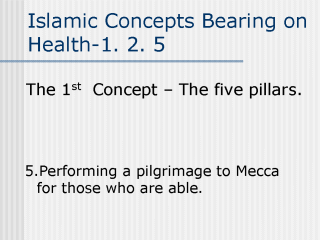| front |1 |2 |3 |4 |5 |6 |7 |8 |9 |10 |11 |12 |13 |14 |15 |16 |17 |18 |19 |20 |21 |22 |23 |24 |25 |26 |review |
 |
Every year more
than a million Muslims go to Saudi Arabia to perform the fifth pillar of Islam, the Hajj,
a pilgrimage to Mecca. This pillar is ordained to only those who are able (both
financially and physically) to do it once in a lifetime (Quran 3:97; 22:27). “…pilgrimage(Hajj)
is a duty that mankind owes to Allah, those who can afford the journey…)” (part of
Quran 3:97). The ahadith collections of both Sahih Bukhari (Volume 2 Book 26 No 589
– 823) and Sahih Muslim (Book 7, chapter 1- 79) is abundant with the sayings of the
prophet Muhammad which affirms the obligatory measure of the Hajj and also provides
explicit guidelines on the rituals of performing the hajj. In addition the ahadith also
speak about the reward for Muslims in performing the Hajj, for instance in the collection
of Sahih Muslim (Book 7, No 3129), he reports; “Abu Huraira (Allah be
pleased with him) reported Allah's Messenger as saying. He who came to this House (Ka'ba)
(with the intention of performing Pilgrimage), and neither spoke indecently nor did he act
wickedly, would return (free from sin) as on the (very first day) his mother bore him”.
In performing the Hajj, Muslims get into regular contact with each other in the Mosque, at Mount Arafat and in their hotels or lodgings. The spiritual journey encourages Muslims to share experiences and knowledge amongst each other through organized sermons by group leaders or social contacts. Its link to health, at the indirect point on the Islamic health continuum, can be said to be the psychodynamics of rituals, beliefs and prayers which play a big role in the building up of an individuals ‘sense of coherence’ through salutogenic mechanism as described by Levin (1996 – See table 1 in chapter two for more details on this) but also through reinforcing factors in the sharing of knowledge, beliefs and values, at the same time in strengthening their positive attitudes while building up their self-efficacy towards these (knowledge, beliefs and values). This is done through the rituals that are demanded in performing the Hajj (Munnajid, 2002; Maududi, 2002). The rituals of Hajj start with the intention in making the trip. With this intention a Muslim makes a commitment into a spiritual journey which until recently could take more than a year. His intention should be backed up by his ability to fund the trip with money that has been earned lawfully, he should also be able not only to cover his expenses during the trip but also to maintain his usual and daily expenses for all those lawfully dependant on him e.g. wife, children, and other kinsmen. Immediately one arrives at the first destination towards Mecca, the Muslim is expected to get into a state of Ihram, which means making official intention (‘Niyyat’) of being on Hajj trip. At this point all are expected to leave behind all their worldly adornments and for men dress in two pieces of white clothes and women in a long dress with a covering on their heads. This is followed by a series of other rituals which to appreciate how powerful they influence a Muslim is the awareness of the Hajji /Hajjah (the one performing the Hajj- male/female) that he/she is one among thousands and thousands of others going through the same ritual. The spiritual journey (the Hajj) also provides for Muslims what might be considered as side effects, which can be ascribed to the more direct link to health in the Islamic health continuum. As part of the rituals a Muslim is involved heavily in carrying out physical exertion through the several Tawaaf (Going round seven times) around the Al –Qaaba (The point where all Muslims round the world face during their prayer, located in Mecca in the Mosque Masjid-il-Haraam) and performing the Sa’ai (running, jogging or walking in a fast pace seven times between al-Safaa’ and al-Marwah located in the Masjid-il-Haraam- more than 500 meters from one point to the other) Reference: Levin, J. S. (1996). How religion influences morbidity and health: Reflections on natural history, Salutogenesis and host resistance. Social Science Medical Journal, Vol 43, No 5, 849-864. Maududi, A. A. (17th June 2002). The Inner Dimensions of Hajj: excerpts from The Fundamentals of Islam. Web siteMunnajid. (17th June 2002). Hajj: its virtues and benefits. http://www.islamicwell.com/Hajj.htm |
| front |1 |2 |3 |4 |5 |6 |7 |8 |9 |10 |11 |12 |13 |14 |15 |16 |17 |18 |19 |20 |21 |22 |23 |24 |25 |26 |review |